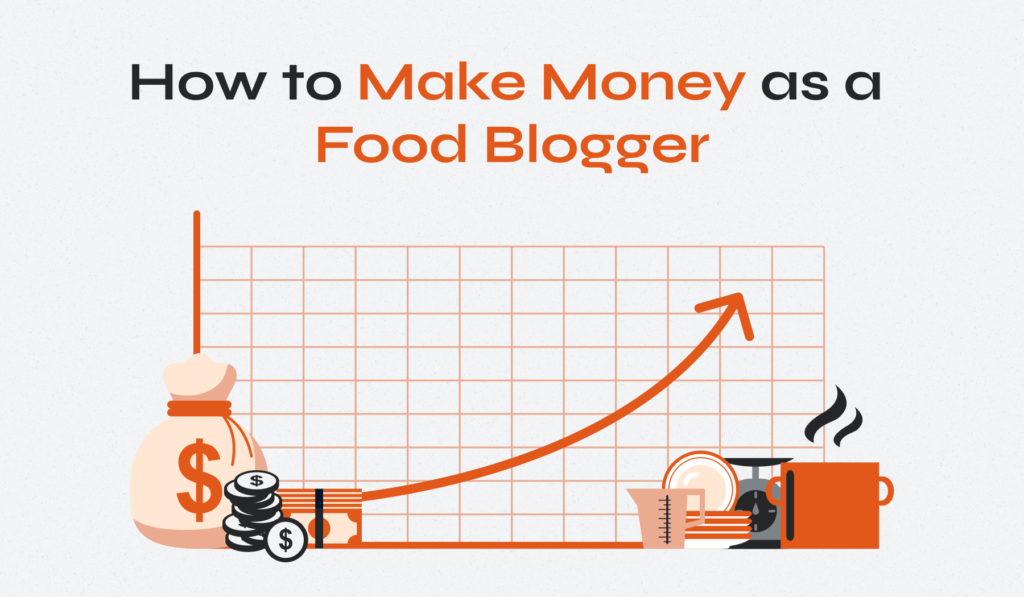
Learning how to make money as a food blogger can be a great way for you to escape the 9-to-5 lifestyle. If you have a passion for cooking and are looking for ways to generate passive income by doing something you truly love, food blogging can be an amazing solution for you.
You’re probably wondering, How do food bloggers make money? Food bloggers have tons of ways to generate revenue, and some are quite ingenious, to be honest.
Table of Contents
- Can You Make Money From a Food Blog?
- 6 Ways to Make Money from a Food Blog
- 3 Bonus Ideas to Monetize a Food Blog
Can You Make Money From a Food Blog?
Before we even go into the main topic, explore different strategies, and teach you how to make money as a food blogger, let’s first paint a picture of what can be achieved regarding food blog revenue.
Your own financial needs are the ones that will mainly dictate how quickly you will be able to make enough money to afford to rely solely on your food blog for an income. Depending on your needs, you should know that earning enough through your blog is going to be a challenge.
While backing away from a challenge is not something we generally recommend, you should know that making this decision needs to be taken seriously and having as much information at hand as humanly possible.
But the silver lining is always what’s waiting for you on the other side. While not all food bloggers end up generating enough money to make a decent living without a regular job, some of them manage to make quite a lot off of their blogs.

Again, with the clear mention that being a food blogger is not automatically synonymous with generating tons of revenue, here are some of the food blogs you should look up to and what they generate.
- Tiffy Cooks: 45-55k USD/month in revenue, without expenses
- The Clean Eating Couple: 150k USD in 2019, no reports later than this
- Stephanie’s Sweet Treats: 128k USD in 2022
- A Sassy Spoon: 17-19k/ month in 2022
As you can see, some of the best food blogs out there generate quite a lot of money. This doesn’t apply to all the food bloggers, but that doesn’t mean that you shouldn’t try it out and see what you can achieve.
There are several key elements to consider when it comes to running a successful food blog. Food recipes are generally the central point of food blogs that have some financial success. Food photography is also quite an important part of the experience.
The most important aspect of being a successful food blogger is to make sure that you are thinking about your readers’ experiences first and foremost. What do you bring to the table? What is your role in the food blogging industry? Do you have a specific niche that you are targeting? What problems is your food blog solving for your readers?
Once you’ve taken into account all these aspects, it’s time to think about monetizing your work. And for maximum performance, you will need a clear strategy.
6 Ways to Make Money from a Food Blog
Making money from your food blog can be challenging. The good news is that you have quite a lot of possible strategies to try out. The beauty of making money online in general is that you can take advantage of several income streams at once, regardless of the niche you are in.
As a rule of thumb, as long as your website has enough traffic, money will be coming your way (in various amounts depending on a variety of factors) one way or another. Here are some of the most important and relevant ways to earn a decent living off of your own food blog.
1. Website Ads
The most obvious way for any website to earn money is to monetize its traffic. This monetization can be done in a series of ways, but the most straightforward is displaying ads. Food blogs with a good amount of traffic can generate a decent stream of revenue through paid ads.
There is a lot to explore on the topic of website ads, but there are some basics we need to cover.
What are website ads? Just as the name indicates, they are forms of display advertising that appear on websites. They can come in different shapes and forms, including paid links, images, banners, and even videos.
One way to go is choosing the old-school path of advertising: adding images and links manually on your website to promote other businesses who are willing to pay you for the exposure you are generating for their brands.
The easier way to go is choosing an ad network.
An ad network is, by its definition, a mediator between publishers and advertisers. That means that instead of going through the hassle of finding your clients and selling your advertising space, you go through a network that does everything for you.
Here are some of the best ad networks you can choose from:
- Google AdSense
- Media.net
- Raptive (Formerly AdThrive)
- Adcash
- Amazon Publisher Services
Each of these platforms comes with its pros and cons, and it is up to you to decide which one fits your needs best.
The most common choice is Google AdSense among food bloggers, though. It pays a decent amount per CPM (cost per mille) and offers some customization options when it comes to the actual ads you will display, depending on the website’s niche.
Selling your advertising space and taking advantage of the amount and quality of your traffic is the number one way for you to start monetizing your food blog.
2. Brand Partnerships
Another common money-earning strategy among food bloggers is making brand deals or brand partnerships. Depending on what you want to achieve, there are several ways you can make brand partnerships.
Your dreams can become a reality, regardless of how approachable or realistic they are. You can dream of co-branding with huge brands from the food industry, or you can make a deal with a mid-range food-related brand to sponsor your activity.
Whether you’re in it for the millions or a couple of much-needed freebies, the food blogging industry provides endless possibilities.
As a food blogger with a website that gets a decent amount of traffic, you can get in touch with a variety of different brands and attempt to make deals with them.

Let’s say, for example, that your recipe blog is focused on grilling, barbecuing, and smoking meat. You have a passion for cooking the most tender ribs. You spend hours perfecting your sauce, cooking times, and temperature. There are many materials involved in this process. You will need:
- Meat. A lot of meat.
- Wood or charcoal for the fire
- A barbecue
- Probably a smoker and a fire pit.
Now, you can pay for all of this yourself, and you are probably going to for quite a while. But as soon as your popularity increases and your website starts getting traffic, you will be able to try and squeeze some freebies from different businesses.
For example, if your website gets enough traffic, you can try making a deal with a local meat vendor (you promote their products on your website, mentioning in every recipe that you use their meat) in exchange for free meat products or a discount on future purchases.
Alternatively, you can make a similar deal with grill or smoker producers and ask for discounts on their products in exchange for the visibility your website can provide for their brands.
Once your WordPress blog becomes popular enough, you can even start working toward co-branding deals where you promote a brand you are working with while that business promotes yours. In our case above, that would translate into you mentioning your meat vendor in the recipes you write, while the meat vendor advertises the fact that you use their products.
3. Affiliate Marketing
Another great way for you to monetize your traffic is to start using affiliate marketing as a money-making tool. It may seem somewhat similar to selling advertising space, but there are some major differences you should know about.
While selling your advertising space through an ad network can be a great way to generate an easy, safe, and somewhat predictable income, affiliate marketing is a bit more volatile.
With ad networks, you are going to be paid a fixed amount based on the number of visitors your website has and how many views and clicks it generates for the ads displayed. This is called CPM and represents a fixed amount you will receive for every 1,000 views the ads have on your website.
This fixed amount depends on the quality of your traffic and other factors too, but it is, regardless, quite easy to predict.
With affiliate marketing, you get paid a certain percentage of the amount your visitors spend on the products you promote as an affiliate. Many food bloggers tend to make quite a splash financially with this strategy because they tend to have a lot of credibility with their audiences.
Let’s keep the same example we used above. You are a food blogger focused on grilling. Your blog contains your tutorials, recipes, and lessons you learned as an expert in barbecues. And because of that, you will have a lot of credibility with your audiences when it comes to promoting certain products.
- Barbecues
- Grilling tools
- Accessories for outdoors
If you become a member of the Amazon affiliate program, for example, you will be able to share the products you are using to prepare the food that becomes the subject of your blog.
If you use a certain type of barbecue that you find better than the rest, you can recommend that to your audience. With the affiliate link you will be using, you will gain a commission from each visitor following that link and purchasing the barbecue you recommended. Here’s how easy it is to add affiliate links to your recipes.
It’s the same with any other product you want to promote. There are several affiliate networks you can choose from, and some of the best ones are:
- Amazon
- CJ Affiliate
- ShareASale
- ClickBank
- Rakuten Advertising
If you are okay with some volatility in terms of your earnings (some months will bring you more revenue than others), affiliate marketing can be a great way to generate income through your website.
You need to keep in mind that affiliate marketing can be an amazing tool. You also need to take into account that the amount of money you will make won’t necessarily be directly related to the traffic you generate.
4. Merchandise
As you gain popularity, more and more possibilities start popping up for you as a food blogger. One of these opportunities that cannot be missed is selling merchandise. People are generally inclined to spend more money than they think to get their hands on a piece of clothing or any kind of merchandise from their favorite online superstar (you).

Whether it’s physical products like a print-version cookbook with your recipes or online goodies (e-books, personalized wallpapers, NFTs), people are going to buy them if they represent you. If people admire you, your brand, and what you provide them with in terms of experience and information, then things can pick up for your online store.
What you sell is up to you, but if you take a look at some of the most famous chefs like Jamie Oliver or Gordon Ramsay, it becomes immediately clear that as long as your name is resounding enough, you can sell anything (from kitchen knives to T-shirts, aprons, or cooking pans).
5. Services
As a food blogger, you need a passion for cooking and food in general. If your knowledge about food and cooking is marketed in the right way and you take advantage of the way your food blog can build your reputation as an individual, chances are you will be able to make some money by offering some of your services.
These can range from food photography, if your specialty is taking interesting and easily recognizable shots of the food you cook or experience as you travel, to consulting or offering other types of services as a personal coach.

As a personality in the food industry, there’s quite a lot of variety in terms of what you can achieve. For example, as a food blogger focused on healthy eating, you can easily develop a coaching program for those who are willing to pay for it. You can work on recipe development to help them lose weight or achieve their personal goals related to food.
Food blogs are generally established as a passion project. If you start a food blog now, you should always think ahead. You can think of your blog as a business from the beginning, and that is going to make things a lot easier for you later on this journey.
Among the services you can start thinking of offering as an established food blogger, the most fruitful in terms of financial success are:
- Food photography
- Recipe development
- Coaching
- Cooking classes
- Personalized meal plan development
Depending on how skilled and creative you are, there may be many other ways for you and your blog to generate all kinds of income streams.
6. Social Media
Social media marketing is a very powerful tool. As a food blogger, you can benefit from all the perks of being an influencer. You can expand your reach considerably if you start using Instagram, YouTube, TikTok, Facebook, Pinterest, or any other platform you are comfortable with.
Instagram is a great platform for sharing food photos and increasing the reach of your blog. Facebook has an amazing community component, and it can offer you a great platform for your readers to interact. You can create and manage your food blog group, where you can post your tasty recipes, promote your blog posts to increase your number of visitors, or simply keep your readers close.
YouTube and TikTok can be amazing choices if you want to involve videography in your recipes. If you want to share video recipes, these two platforms offer amazing support, including great customization options for your videos.
One thing to remember about the way you manage your social media channels is that it can be quite a difficult challenge. If you want to be in charge of everything, from managing your website to every social media account you create for your blog, things can become overwhelming quite quickly.
The upside is that you can generate quite a lot of income through sponsored posts, brand deals, video reels with ads, and many other channels. The best thing to do would be to hire a social media expert to teach you how to take full advantage of everything social platforms can provide you with, both in terms of actual revenue streams and exposure.
3 Bonus Ideas to Monetize a Food Blog
While the methods above have all been tried and tested by actual food bloggers who share their strategies, there are some more things you could try. Many experts recommend different other monetizing methods. These haven’t been vetted by actual food bloggers, but they do make sense and they have been recommended by expert bloggers from other niches.
Here are some of the most relevant and interesting examples.
1. Develop an App for Your Blog
Your food blog can be a great way for you to engage visitors to a certain extent, but if you want to take things further, you can start thinking about investing in developing your app.

This can generate income in a variety of ways:
- you can ask people to pay a one-time fixed amount to get the app
- you can make your app available to your customers on a monthly subscription basis
- you can offer the app for free but use display ads to generate income through the app.
You should know that creating an app is not as easy as it sounds. Some platforms offer solutions to creating apps easily, but the results are not going to be amazing.
Making an app through an agency or with the help of an experienced developer can be quite costly. You should only make this investment if your blog already has some notoriety and gets constant traffic, generating a steady income through other methods.
2. Publish Your Content on Substack
If your content is specifically targeting a segment of readers that is part of a tight niche, you can take advantage of your knowledge to create special high quality content that is only available through a paid subscription on platforms like Substack.
For example, if your blog is dedicated to people who want to learn how to lose weight, you can use your blog as a platform to attract readers who are interested in nutrition and healthy eating.
You can use your blog to offer some advice and partial solutions, while your premium content with more accurate and relevant information is published on Substack and available to paying customers.
3. Sell Access to Premium Articles on Your Blog
While social media platforms and all the other gimmicks are a great way to diversify your income streams, the main source of income should be your actual website.
On top of website ads and affiliate deals or brand sponsorships, another great way to make money while creating content is to sell access to a premium section of your website.
Whether it’s access to your most precious recipes, a section of the website where people can learn additional secrets about cooking, or simply providing an ad-free experience, premium subscriptions are a thing for a reason: they work.
Bottom Line
Regardless of the way you decide to monetize your food blog, one thing is for sure: the number of possibilities you have is huge. Being a full-time food blogger is not going to be easy, but you will certainly manage to make money if you approach this activity with a good mindset.
The key to getting the most value from your food blog is diversifying. The more income streams you will manage to take advantage of, the more you will make in the end. There are, however, some money-making strategies and techniques that simply cannot be avoided:
- Display advertising: monetizing traffic is essential and easy
- Affiliate marketing: promoting products is easy if you use them and believe in their potential. As soon as your audience starts believing that your opinions are worthy, they will start buying what you recommend.
- Social media: being a food influencer on any social media platform while also running your food blog brings endless possibilities in terms of income.
There are probably many other strategies you can use for making money off your food blog. Be as creative as you want or can, and choose whatever feels right for you and your business.